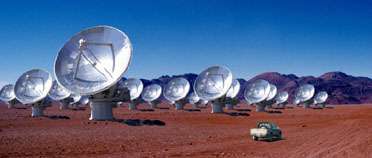Studying the Past, Pioneering the Future

Astronomers are meeting this week in Cambridge, Mass., to discuss recent advances generated by a new astronomical facility-the Submillimeter Array (SMA) on Mauna Kea, Hawaii. A joint project of the Smithsonian Astrophysical Observatory (SAO) and the Academia Sinica Institute of Astronomy and Astrophysics (ASIAA), the SMA has opened a new window onto the cosmos by observing radiation from some of the coldest, dustiest, and most distant objects in the universe.
Image: The Atacama Large Millimeter Array (ALMA), shown here in this artist's conception, will follow the trail blazed by the SMA and bring a depth of understanding to planet, star and galaxy formation in the southern skies. To be located in Chile, ALMA will be comprised of 64 12-meter-diameter movable antennas, providing a resolution as fine as 0.01 arcseconds. Credit: National Astronomical Observatory of Japan (NAOJ)
"The SMA is the latest in a long line of cutting-edge research facilities developed by the Smithsonian," said Jim Moran, SMA director. "It demonstrates the Smithsonian's commitment to remaining at the frontier of scientific research."
Atop the highest volcanic peak in the Hawaiian Island chain, the SMA explores the universe by detecting light at wavelengths (or colors) that are not visible to the human eye. It receives millimeter and submillimeter radiation, so named because the wavelength ranges from 0.3 to 1.7 millimeters, or 0.01 to 0.07 inches. The SMA combines signals from eight 6-meter-diameter movable antennas to achieve very high resolution, comparable to the best ground-based optical telescopes.
At submillimeter wavelengths, the SMA can peer into the most distant reaches of the observable universe, studying objects whose light has taken billions of years to reach the earth. In doing so, it sees those objects as they existed billions of years ago, when the universe was a fraction of its present age.
SMA observations have uncovered some surprises. For example, astronomers recently focused on a class of objects called submillimeter galaxies, which were discovered using the James Clerk Maxwell Telescope, also on Mauna Kea. Hubble images were unable to discern the nature of these primordial galaxies because they were too distant or too dusty.
The SMA has clarified the nature of these mystery objects, revealing that many submillimeter galaxies are undergoing intense bursts of star formation hidden behind massive amounts of dust.
"The SMA literally has seen what Hubble can't see," said astronomer Daisuke Iono of the Harvard-Smithsonian Center for Astrophysics (CfA). "The unique capabilities of the SMA allow it to detect and make high-resolution images of these young galaxies."
"With the SMA, we immediately pinpointed the exact location of two galaxies that were actively forming stars at an exceptional rate more than 10 billion years ago," added astronomer Alison Peck (CfA).
SMA observations are expected to help clarify the nature of many cosmic objects from distant galaxies to nearby star forming regions. It will examine those objects at high angular resolution in preparation for more detailed and more sensitive studies by its eventual successor, the Atacama Large Millimeter Array (ALMA).
"SMA is blazing a path of discovery across northern skies that ALMA will follow as it brings a depth of understanding to planet, star and galaxy formation in the southern skies," said Al Wootten, ALMA project scientist.
Headquartered in Cambridge, Mass., the Harvard-Smithsonian Center for Astrophysics (CfA) is a joint collaboration between the Smithsonian Astrophysical Observatory and the Harvard College Observatory. CfA scientists, organized into six research divisions, study the origin, evolution and ultimate fate of the universe.
Source: Harvard-Smithsonian Center for Astrophysics
















